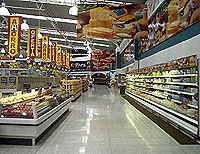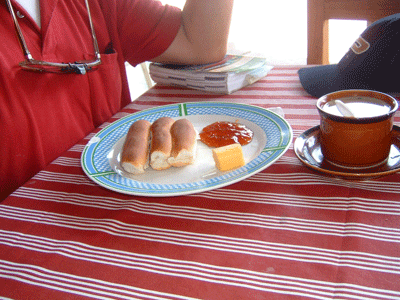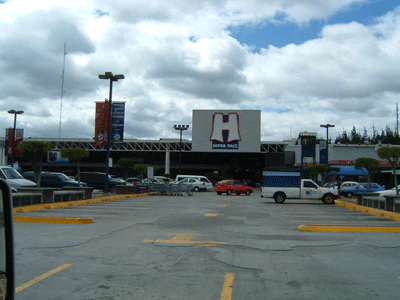|
Eating out was inexpensive and good. You can find great food in the markets and at the comodores where the locals eat.
|
||
|
|
Even when you go to what you think is an
Americanized fast food place, you can land up with some interesting
things. John ordered French toast and received little hot dog
buns at a sidewalk restaurant in Granada, Nicaragua.
|
|
|
Eating in was not so easy. |
||
|
I found the meat
unattractive to buy in the mercado. It was very lean and therefore
tough, and I was not familiar enough to tell the butcher which part of
the carcass to hack off for us. Chicken was more recognizable. A solution is
to ask him to grind some beef for you, but this is not recommended.
Even though the cut might look good, you donít know how clean the
grinder is. Cut your meat into small pieces or take a grinder with you
that you can clean yourself. We took a precious supply of frozen meat with us. The large supermarcados sell familiar prepackaged, plastic-wrapped meat, however, it is still very lean and therefore tough. Note that all meat and fresh produce was taken from us at the border to Belize. |
||
|
|
We bought what vegetables looked good on any particular day. Produce didnít last so we usually shopped each day. Lettuce was hard to find as were most green vegetables. We did find one great vegetable stall near Cuatros Caminos, on the Pan-American Highway just outside Quetzaltenango, Guatemala (this is a major intersection bustling with activity). They had a great variety fresh supplies of cauliflower, beans, beats and other fresh greens. |
|
|
Bananas became a staple and it was a great opportunity to try some of the unusual and very tasty varieties that abounded. The very small ones are very sweet and flavorful. Mangos and melons could be found everywhere |
|
|
|
|
There are cashew nut trees growing all over the place. They can even be found as part of the landscaping in cities, growing on the median strips. The fruit is all pulp and very juicy. It is a little too bitter for my liking, but many people enjoy it. The interesting thing is that the nut is on the bottom of the fruit, rather than inside it. The shell is almost impossible to crack. The nut is thought to be bad for you, if not poisonous, if eaten raw. I have been eating raw cashew nuts my entire life. Both nut and fruit are said to be good for the kidneys, a concept probably drawn from the shape of the nut. Enjoy! |
|
|
Regional
supermarkets can be found in the major cities. Wal-Mart is in
Mexico and have plans to enter Central America. They stock just
about everything you would need, even if some of the items like peanut
butter and cornflakes were rather expensive. There are six Hiper Paiz stores in
Guatemala and two in El Salvador. They have their own security
and every time we asked they said we could park in their lot.
 Hiper Paiz is the Wal-Mart Supercenter of Guatemala and El Salvador |
|
|
|
Individual size water bottles became a premium so we refilled the ones we had from the five liter ones that were readily available. |
|
|
|
Dog food was available in the supermercados as well as pet shops in the larger cities. |
|
|
|
Corn tortillas are mostly omnipresent south of the border except in Panama where you have to look to find them. Mexico's tortillas are about 6" in diameter, thin and pressed with a small machine and are better than the ones we get packaged in the US but the least tasty. Guatemalan tortillas are thicker, made by hand and about 3 1/2 " in diameter. In El Salvador they are also small, thicker than the Guatemalan ones and made by hand. Colleen and I think El Salvador and Guatemala get the prize for the best tortillas and Mexico the worst. Joyce and Larry have just the opposite opinion about the best and worst tortillas. We ate some pretty strange things while we were in Mexico and Central America. Fried intestines, cow's foot soup, fried grasshoppers, and cow's head soup are some of the strange items. Some of them were good and some wouldn't merit a second try. |
||




